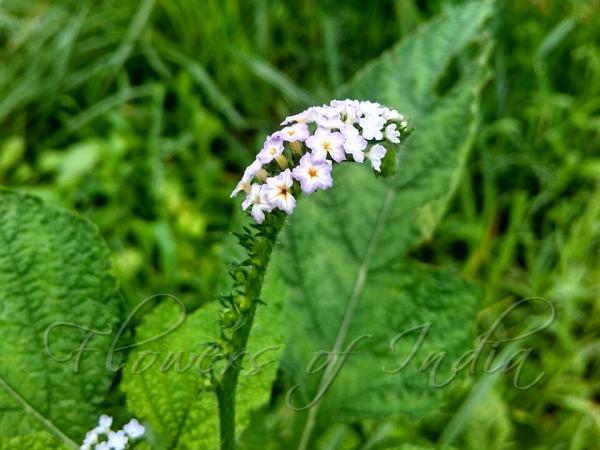|
| Indian Heliotrope |
|

|

|
|
|
|
Photo: |
Botanical name: Heliotropium indicum Family: Boraginaceae (Forget-me-not family)
Synonyms: Heliotropium africanum
Synonyms: Heliotropium africanum
Indian Heliotrope is a herb, slightly woody at
base,
with a long taproot, stem erect, unbranched or branches few, 30-80 cm
tall; leaves alternate or sometimes nearly opposite, distinctly
stalked,
leaf-stalks to 5 cm long, blade narrowing into wings on the leaf-stalk
from a
somewhat flat base, ovate-deltoid, margin slightly wavy-crisped, 2.5-10
cm long,
1-5 cm wide, pointed (blunt), lateral veins 4-7 pairs. Flowers are born
in
a long tapering cluster at branch-ends, tip coiled, axis up to 20 cm
long. The inflorescence uncoils
after the central flowers, which are the oldest, mature. The flowers
are
arranged on only one side of the inflorescence. Flowers are pale violet
(lilac) with a yellow throat, but fading to dull white, calyx-lobes
linear-lanceshaped, fringed with hairs, 2 mm long; flower-tube 4-5 mm
long; petals rounded. Fruit is 3.5 mm long, ovoid, ribbed, separating
into 2 nutlets each 2-celled, 3-3.5 mm long. Indian Heliotrope is found
in all tropical world.
Medicinal uses: The plant has been widely used
for centuries to treat warts, inflammations and tumours. Throughout
tropical Africa it is used as an analgesic to ease rheumatic pain, as a
diuretic and to treat numerous skin problems including yaws, urticaria,
scabies, ulcers, eczema and impetigo. Throughout the Continent, there
is a wide variation in the plant parts that are used, and also in
methods of preparation and administration. In the Philippines, the
plant is chiefly used as a traditional medicine. The extracted juice
from the pounded leaves of the plants is used on wounds, skin ulcers
and furuncles.
The plant has been widely used
for centuries to treat warts, inflammations and tumours. Throughout
tropical Africa it is used as an analgesic to ease rheumatic pain, as a
diuretic and to treat numerous skin problems including yaws, urticaria,
scabies, ulcers, eczema and impetigo. Throughout the Continent, there
is a wide variation in the plant parts that are used, and also in
methods of preparation and administration. In the Philippines, the
plant is chiefly used as a traditional medicine. The extracted juice
from the pounded leaves of the plants is used on wounds, skin ulcers
and furuncles.
Medicinal uses:
 The plant has been widely used
for centuries to treat warts, inflammations and tumours. Throughout
tropical Africa it is used as an analgesic to ease rheumatic pain, as a
diuretic and to treat numerous skin problems including yaws, urticaria,
scabies, ulcers, eczema and impetigo. Throughout the Continent, there
is a wide variation in the plant parts that are used, and also in
methods of preparation and administration. In the Philippines, the
plant is chiefly used as a traditional medicine. The extracted juice
from the pounded leaves of the plants is used on wounds, skin ulcers
and furuncles.
The plant has been widely used
for centuries to treat warts, inflammations and tumours. Throughout
tropical Africa it is used as an analgesic to ease rheumatic pain, as a
diuretic and to treat numerous skin problems including yaws, urticaria,
scabies, ulcers, eczema and impetigo. Throughout the Continent, there
is a wide variation in the plant parts that are used, and also in
methods of preparation and administration. In the Philippines, the
plant is chiefly used as a traditional medicine. The extracted juice
from the pounded leaves of the plants is used on wounds, skin ulcers
and furuncles. | Identification credit: Kiran Srivastava | Photographed in Chakradharpur, Chhattisgarh & SGNP, Mumbai. |
• Is this flower misidentified? If yes,